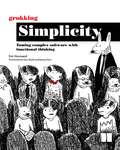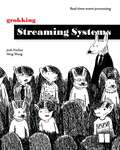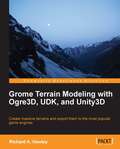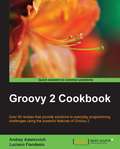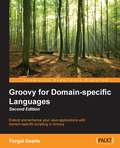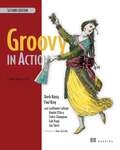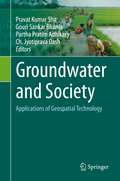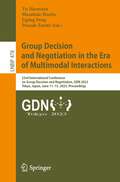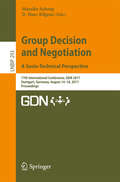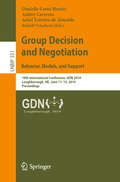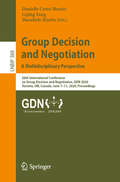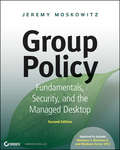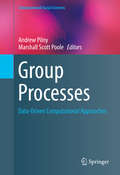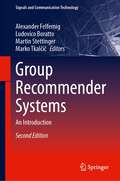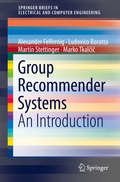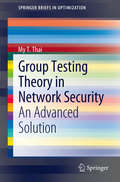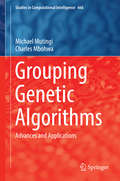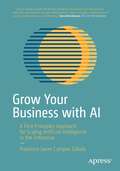- Table View
- List View
Grokking Simplicity: Taming complex software with functional thinking
by Eric NormandGrokking Simplicity is a friendly, practical guide that will change the way you approach software design and development.Summary Distributed across servers, difficult to test, and resistant to modification—modern software is complex. Grokking Simplicity is a friendly, practical guide that will change the way you approach software design and development. It introduces a unique approach to functional programming that explains why certain features of software are prone to complexity, and teaches you the functional techniques you can use to simplify these systems so that they&’re easier to test and debug. Purchase of the print book includes a free eBook in PDF, Kindle, and ePub formats from Manning Publications. About the technology Developers rightly fear the unintended complexity that infects most code. This book shows you how to write software that keeps complexity close to its inherent minimum. As you write software you should distinguish between code that alters your system&’s state, and code that does not. Once you learn to make that distinction, you can refactor much of your state-altering &“actions&” into stateless &“calculations.&” Your software will be simpler. About the book The book also teaches you to solve the complex timing bugs that inevitably creep into asynchronous and multithreaded code. In advanced sections of the book you learn how composable abstractions help avoid repeating code and open up new levels of expressivity. What's inside Patterns for simpler code Powerful time modeling approaches to simplify asynchronous code How higher-order functions can make code reusable and composable About the reader For intermediate and advanced developers building complex software. Exercises, illustrations, self-assessments, and hands-on examples lock in each new idea. About the author Eric Normand is an expert software developer who has been an influential teacher of functional programming since 2007. Table of Contents 1 Welcome to Grokking Simplicity 2 Functional thinking in action PART 1 - ACTIONS, CALCULATIONS, AND DATA 3 Distinguishing actions, calculations, and data 4 Extracting calculations from actions 5 Improving the design of actions 6 Staying immutable in a mutable language 7 Staying immutable with untrusted code 8 Stratified design, part 1 9 Stratified design, part 2 PART 2 - FIRST-CLASS ABSTRACTIONS 10 First-class functions, part 1 11 First-class functions, part 2 12 Functional iteration 13 Chaining functional tools 14 Functional tools for nested data 15 Isolating timelines 16 Sharing resources between timelines 17 Coordinating timelines 18 Reactive and onion architectures 19 The functional journey ahead
Grokking Streaming Systems: Real-time event processing
by Ning Wang Josh FischerA friendly, framework-agnostic tutorial that will help you grok how streaming systems work—and how to build your own!In Grokking Streaming Systems you will learn how to: Implement and troubleshoot streaming systems Design streaming systems for complex functionalities Assess parallelization requirements Spot networking bottlenecks and resolve back pressure Group data for high-performance systems Handle delayed events in real-time systems Grokking Streaming Systems is a simple guide to the complex concepts behind streaming systems. This friendly and framework-agnostic tutorial teaches you how to handle real-time events, and even design and build your own streaming job that&’s a perfect fit for your needs. Each new idea is carefully explained with diagrams, clear examples, and fun dialogue between perplexed personalities! About the technology Streaming systems minimize the time between receiving and processing event data, so they can deliver responses in real time. For applications in finance, security, and IoT where milliseconds matter, streaming systems are a requirement. And streaming is hot! Skills on platforms like Spark, Heron, and Kafka are in high demand. About the book Grokking Streaming Systems introduces real-time event streaming applications in clear, reader-friendly language. This engaging book illuminates core concepts like data parallelization, event windows, and backpressure without getting bogged down in framework-specific details. As you go, you&’ll build your own simple streaming tool from the ground up to make sure all the ideas and techniques stick. The helpful and entertaining illustrations make streaming systems come alive as you tackle relevant examples like real-time credit card fraud detection and monitoring IoT services. What's inside Implement and troubleshoot streaming systems Design streaming systems for complex functionalities Spot networking bottlenecks and resolve backpressure Group data for high-performance systems About the reader No prior experience with streaming systems is assumed. Examples in Java. About the author Josh Fischer and Ning Wang are Apache Committers, and part of the committee for the Apache Heron distributed stream processing engine. Table of Contents PART 1 GETTING STARTED WITH STREAMING 1 Welcome to Grokking Streaming Systems 2 Hello, streaming systems! 3 Parallelization and data grouping 4 Stream graph 5 Delivery semantics 6 Streaming systems review and a glimpse ahead PART 2 STEPPING UP 7 Windowed computations 8 Join operations 9 Backpressure 10 Stateful computation 11 Wrap-up: Advanced concepts in streaming systems
Grokking Web Application Security
by Malcolm McDonaldWhen you launch an application on the web, every hacker in the world has access to it. Are you sure your web apps can stand up to the most sophisticated attacks?Trying to teach yourself about web security from the internet can feel like walking into a huge disorganized library—one where you can never find what you need, and the wrong advice might endanger your application! You need a single, all-in-one guide to securing your apps against all the attacks they can and will face. You need Grokking Web Application Security. This brilliantly illustrated and clearly written guide delivers detailed coverage on: Browser security, including sandboxing, the same-origin policy, and cookie security Securing web servers with input validation, escaping of output, and defense in depth A development process that prevents security bugs Browser vulnerabilities, from cross-site scripting and cross-site request forgery, to clickjacking Network vulnerabilities, such as man-in-the-middle attacks, SSL-stripping, and DNS poisoning Authentication vulnerabilities, such as brute forcing of credentials with single sign-on or multi-factor authentication Authorization vulnerabilities, such as broken access control and session jacking How to use encryption in web applications Injection attacks, command execution attacks, and remote code execution attacks Malicious payloads that can be used to attack XML parsers and file upload functions Grokking Web Application Security teaches you how to build web apps that are ready and resilient to any attack. It&’s laser-focused on what the working programmer needs to know about web security. In it, you&’ll find practical recommendations for both common and not-so-common vulnerabilities—everything from SQL injection to cross-site scripting inclusion attacks. You&’ll learn what motivates hackers, discover the latest tools for identifying issues, and set up a development lifecycle that catches problems early. Read it cover to cover for a comprehensive overview of web security, and dip in as a reference whenever you need to tackle a specific vulnerability. About the technology Application security is a front-burner concern for web developers. Whether working on the UI with a frontend framework or building out the server side, it&’s up to you to understand the threats and know exactly how to keep the black hats from getting the upper hand. About the book Grokking Web Application Security covers everything a working developer needs to know about securing applications in the browser and on the server. The tested techniques apply to any stack and are illustrated with concrete examples plucked from author Malcolm McDonald&’s extensive career. You&’ll discover must-implement security principles and even learn the fascinating tools and techniques the bad guys use to crack systems. What's inside A security-first development process Encryption in web applications Supply-chain and API attacks What to do when a hacker gets in About the reader For readers who understand basic web application design and technologies. About the author Malcolm McDonald is a security engineer with 20 years of experience across investment banking, start-ups, and PayPal, and he is the creator of hacksplaining.com. The technical editor on this book was Rajvardhan Oak.
Grome Terrain Modeling with Ogre3D, UDK, and Unity3D
by Richard HawleyThis book is a practical guide with examples and clear steps to explain terrain modeling with Grome.If you're a developer or artist looking for a guide to walk you through GROME 3.1, then this book is for you. This book will help you from the first step to exporting a terrain as a workable art asset in a game engine
Groovy 2 Cookbook
by Andrey Adamovich Luciano FiandesioThis book follows a Cookbook style and is packed with intermediate and advanced level recipes.This book is for Java developers who have an interest in discovering new ways to quickly get the job done using a new language that shares many similarities with Java. The book's recipes start simple, therefore no previous Groovy experience is required to understand the code and the explanations accompanying the examples.
Groovy for Domain-Specific Languages
by Fergal DearleThis book is a practical tutorial, walking the reader through examples of building DSLs with Groovy covering meta-programming with Groovy. Some complex concepts are covered in the book but we go through these in a clear and methodically way so that readers will gain a good working knowledge of the techniques involved. This book is for Java software developers who have an interest in building domain scripting into their Java applications. No knowledge of Groovy is required, although it will be helpful. The book does not teach Groovy, but quickly introduces the basic ideas of Groovy. An experienced Java developer should have no problems with these and move quickly on to the more involved aspects of creating DSLs with Groovy. No experience of creating a DSL is required. The book should also be useful for experienced Groovy developers who have so far only used Groovy DSLs such as Groovy builders and would like to start building their own Groovy-based DSLs.
Groovy for Domain-specific Languages - Second Edition
by Fergal DearleExtend and enhance your Java applications with domain-specific scripting in Groovy About This Book * Build domain-specific mini languages in Groovy that integrate seamlessly with your Java apps with this hands-on guide * Increase stakeholder participation in the development process with domain-specific scripting in Groovy * Get up to speed with the newest features in Groovy using this second edition and integrate Groovy-based DSLs into your existing Java applications. Who This Book Is For This book is for Java software developers who have an interest in building domain scripting into their Java applications. No knowledge of Groovy is required, although it will be helpful. This book does not teach Groovy, but quickly introduces the basic ideas of Groovy. An experienced Java developer should have no problems with these and move quickly on to the more involved aspects of creating DSLs with Groovy. No experience of creating a DSL is required. What You Will Learn * Familiarize yourself with Groovy scripting and work with Groovy closures * Use the meta-programming features in Groovy to build mini languages * Employ Groovy mark-up and builders to simplify application development * Familiarize yourself with Groovy mark-up and build your own Groovy builders * Build effective DSLs with operator overloading, command chains, builders, and a host of other Groovy language features * Integrate Groovy with your Java and JVM based applications In Detail The times when developing on the JVM meant you were a Java programmer have long passed. The JVM is now firmly established as a polyglot development environment with many projects opting for alternative development languages to Java such as Groovy, Scala, Clojure, and JRuby. In this pantheon of development languages, Groovy stands out for its excellent DSL enabling features which allows it to be manipulated to produce mini languages that are tailored to a project's needs. A comprehensive tutorial on designing and developing mini Groovy based Domain Specific Languages, this book will guide you through the development of several mini DSLs that will help you gain all the skills needed to develop your own Groovy based DSLs with confidence and ease. Starting with the bare basics, this book will focus on how Groovy can be used to construct domain specific mini languages, and will go through the more complex meta-programming features of Groovy, including using the Abstract Syntax Tree (AST). Practical examples are used throughout this book to de-mystify these seemingly complex language features and to show how they can be used to create simple and elegant DSLs. Packed with examples, including several fully worked DSLs, this book will serve as a springboard for developing your own DSLs. Style and approach This book is a hands-on guide that will walk you through examples for building DSLs with Groovy rather than just talking about "metaprogramming with Groovy". The examples in this book have been designed to help you gain a good working knowledge of the techniques involved and apply these to producing your own Groovy based DSLs.
Groovy in Action
by Paul King Cédric Champeau Dierk Koenig Hamlet D'ArcySummaryGroovy in Action, Second Edition is a thoroughly revised, comprehensive guide to Groovy programming. It introduces Java developers to the dynamic features that Groovy provides, and shows how to apply Groovy to a range of tasks including building new apps, integration with existing code, and DSL development. Covers Groovy 2.4.Purchase of the print book includes a free eBook in PDF, Kindle, and ePub formats from Manning Publications.About the TechnologyIn the last ten years, Groovy has become an integral part of a Java developer's toolbox. Its comfortable, common-sense design, seamless integration with Java, and rich ecosystem that includes the Grails web framework, the Gradle build system, and Spock testing platform have created a large Groovy communityAbout the BookGroovy in Action, Second Edition is the undisputed definitive reference on the Groovy language. Written by core members of the Groovy language team, this book presents Groovy like no other can—from the inside out. With relevant examples, careful explanations of Groovy's key concepts and features, and insightful coverage of how to use Groovy in-production tasks, including building new applications, integration with existing code, and DSL development, this is the only book you'll need. Updated for Groovy 2.4.Some experience with Java or another programming language is helpful. No Groovy experience is assumed.What's InsideComprehensive coverage of Groovy 2.4 including language features, libraries, and AST transformationsDynamic, static, and extensible typingConcurrency: actors, data parallelism, and dataflowApplying Groovy: Java integration, XML, SQL, testing, and domain-specific language supportHundreds of reusable examplesAbout the AuthorsAuthors Dierk König, Paul King, Guillaume Laforge, Hamlet D'Arcy, Cédric Champeau, Erik Pragt, and Jon Skeet are intimately involved in the creation and ongoing development of the Groovy language and its ecosystem.Table of ContentsPART 1 THE GROOVY LANGUAGEYour way to GroovyOverture: Groovy basicsSimple Groovy datatypesCollective Groovy datatypesWorking with closuresGroovy control structuresObject orientation, Groovy styleDynamic programming with GroovyCompile-time metaprogramming and AST transformationsGroovy as a static languagePART 2 AROUND THE GROOVY LIBRARYWorking with buildersWorking with the GDKDatabase programming with GroovyWorking with XML and JSONInteracting with Web ServicesIntegrating GroovyPART 3 APPLIED GROOVYUnit testing with GroovyConcurrent Groovy with GParsDomain-specific languagesThe Groovy ecosystem
Groundwater and Society: Applications of Geospatial Technology
by Gouri Sankar Bhunia Pravat Kumar Shit Partha Pratim Adhikary Ch. Jyotiprava DashThis volume advances the scientific understanding, development, and application of geospatial technologies related to groundwater resource management, mapping, monitoring, and modelling using up-to-date remote sensing and GIS techniques. The book further provides a critical analysis of the debates and discourses surrounding groundwater resources and society, illustrates the relationship between groundwater resources and precision agriculture for societal development, and describes novel, region-specific management strategies and techniques for sustainability with case studies. The book is organized into three parts: (I) Groundwater resources and societal development; (II) Groundwater availability, quality and pollution; and (III) Sustainable groundwater resources management. Each section begins with a short introduction that includes an overview of the papers in that section. Individual chapters focus on the core themes of research and knowledge along with some topics that have received lesser attention. The book will be of interest to water resource planners and decision-makers, academic researchers, policy makers, NGOs, and academic researchers and students in Geography, Geophysics, Hydrology, Remote Sensing & GIS, Agriculture, Soil Science, and Agronomy.
Group Cell Architecture for Cooperative Communications
by Ping Zhang Qimei Cui Xiaodong Xu Xiaofeng TaoDriven by the increasing demand for capacity and Quality of Service in wireless cellular networks and motivated by the distributed antenna system, the authors proposed a cooperative communication architecture--Group Cell architecture, which was initially brought forward in 2001. Years later, Coordinated Multiple-Point Transmission and Reception (CoMP) for LTE-Advanced was put forward in April 2008, as a tool to improve the coverage of cells having high data rates, the cell-edge throughput and/or to increase system throughput. This book mainly focuses on the Group Cell architecture with multi-cell generalized coordination, Contrast Analysis between Group Cell architecture and CoMP, Capacity Analysis, Slide Handover Strategy, Power Allocation schemes of Group Cell architecture to mitigate the inter-cell interference and maximize system capacity and the trial network implementation and performance evaluations of Group Cell architecture.
Group Decision and Negotiation in an Uncertain World: 18th International Conference, GDN 2018, Nanjing, China, June 9-13, 2018, Proceedings (Lecture Notes in Business Information Processing #315)
by Rudolf Vetschera Haiyan Xu Ye Chen Gregory KerstenThis book constitutes the refereed proceedings of the 18th International Conference on Group Decision and Negotiation, GDN 2018, held in Nanjing, China, in June 2018. The field of Group Decision and Negotiation focuses on decision processes with at least two participants and a common goal but conflicting individual goals. Research areas of Group Decision and Negotiation include electronic negotiations, experiments, the role of emotions in group decision and negotiations, preference elicitation and decision support for group decisions and negotiations, and conflict resolution principles.The 15 full papers presented in this volume were carefully reviewed and selected from 143 submissions. They were organized in topical sections named: theoretical concepts of group decision and negotiation; decision support and behavior in group decision and negotiation; and applications of group decision and negotiations.
Group Decision and Negotiation in the Era of Multimodal Interactions: 23rd International Conference on Group Decision and Negotiation, GDN 2023, Tokyo, Japan, June 11–15, 2023, Proceedings (Lecture Notes in Business Information Processing #478)
by Pascale Zaraté Liping Fang Masahide Horita Yu MaemuraThis book constitutes the refereed proceedings of the 23rd International Conference on Group Decision and Negotiation, GDN 2023, which took place in Tokyo, Japan during June 11–15, 2023.The field of Group Decision and Negotiation focuses on decision processes with at least two participants and a common goal but conflicting individual goals. Research areas of Group Decision and Negotiation include electronic negotiations, experiments, the role of emotions in group decision and negotiations, preference elicitation and decision support for group decisions and negotiations, and conflict resolution principles. This year’s conference focusses on multimodal interactions. The 11 full papers presented in this volume were carefully reviewed and selected from 102 submissions. They were organized in the following topical sections: Taking a step back: Critically re-examining technology interactions with group decision and negotiation; preference modeling and multi-criteria decision-making; and conflict modeling and distributive mechanisms.
Group Decision and Negotiation. A Socio-Technical Perspective: 17th International Conference, GDN 2017, Stuttgart, Germany, August 14-18, 2017, Proceedings (Lecture Notes in Business Information Processing #293)
by D. Marc Kilgour Mareike SchoopThis book constitutes the refereed proceedings of the 17th International Conference on Group Decision and Negotiation, GDN 2017, held in Stuttgart, Germany, in August 2017. The field of Group Decision and Negotiation focuses on decision processes with at least two participants and a common goal but conflicting individual goals. Research areas of Group Decision and Negotiation include electronic negotiations, experiments, the role of emotions in group decision and negotiations, preference elicitation and decision support for group decisions and negotiations, and conflict resolution principles.The 14 full papers presented in this volume were carefully reviewed and selected from 87 submissions. They were organized in topical sections named: general topics in group decision and negotiation; conflict resolution; emotions in group decision and negotiation; negotiation support systems and studies; and preference modeling for group decision and negotiation. The book also contains two invited talks in full paper length.
Group Decision and Negotiation: 19th International Conference, GDN 2019, Loughborough, UK, June 11–15, 2019, Proceedings (Lecture Notes in Business Information Processing #351)
by Adiel Teixeira de Almeida Rudolf Vetschera Danielle Costa Morais Ashley CarrerasThis book constitutes the refereed proceedings of the 19th International Conference on Group Decision and Negotiation, GDN 2019, held in Loughborough, UK, in June 2019. The field of Group Decision and Negotiation focuses on decision processes with at least two participants and a common goal but conflicting individual goals. Research areas of Group Decision and Negotiation include electronic negotiations, experiments, the role of emotions in group decision and negotiations, preference elicitation and decision support for group decisions and negotiations, and conflict resolution principles. The 17 full papers presented in this volume were carefully reviewed and selected from 98 submissions. They were organized in topical sections named: preference modeling for group decision and negotiations; collaborative decision making processes; conflict resolution; behavioral OR, and negotiation support systems and studies.
Group Decision and Negotiation: 20th International Conference on Group Decision and Negotiation, GDN 2020, Toronto, ON, Canada, June 7–11, 2020, Proceedings (Lecture Notes in Business Information Processing #388)
by Liping Fang Danielle Costa Morais Masahide HoritaThis book constitutes the refereed proceedings of the 20th International Conference on Group Decision and Negotiation, GDN 2020, which was planned to be held in Toronto, ON, Canada, during June 7–11, 2020. The conference was cancelled due to the Coronavirus pandemic. Nevertheless, it was decided to publish the proceedings, because the review process had already been completed at the time the cancellation was decided. The field of Group Decision and Negotiation focuses on decision processes with at least two participants and a common goal but conflicting individual goals. Research areas of Group Decision and Negotiation include electronic negotiations, experiments, the role of emotions in group decision and negotiations, preference elicitation and decision support for group decisions and negotiations, and conflict resolution principles. The 14 full papers presented in this volume were carefully reviewed and selected from 75 submissions. They were organized in topical sections named: Conflict Resolution, Preference Modeling for Group Decision and Negotiation, Intelligent Group Decision Making and Consensus Process, Collaborative Decision Making Processes.
Group Decision and Negotiation: 22nd International Conference on Group Decision and Negotiation, GDN 2022, Virtual Event, June 12–16, 2022, Proceedings (Lecture Notes in Business Information Processing #454)
by Liping Fang Danielle Costa MoraisThis book constitutes the refereed proceedings of the 22nd International Conference on Group Decision and Negotiation, GDN 2022, which was held virtually during June 12–16, 2022. The field of Group Decision and Negotiation focuses on decision processes with at least two participants and a common goal but conflicting individual goals. Research areas of Group Decision and Negotiation include electronic negotiations, experiments, the role of emotions in group decision and negotiations, preference elicitation and decision support for group decisions and negotiations, and conflict resolution principles. This year’s conference focusses on methodological and practical issues. The 9 full papers presented in this volume were carefully reviewed and selected from 68 submissions. They were organized in the following topical sections: Preference modeling for group decision and negotiation; conflict resolution; collaborative decision making processes.
Group Policy
by Jeremy MoskowitzThe Ultimate Book on Group Policy Freshly updated to include Windows 7, Windows 8 and Windows Server 2012, Group Policy: Fundamentals, Security, and the Managed Desktop, Second Edition is the book for learning everything you need to know about Group Policy, no matter which version of Windows you use. Microsoft Group Policy MVP Jeremy Moskowitz covers it all--major Group Policy categories, what Windows 8 and Windows Server 2012 bring to the table, and smart ways to tackle tough desktop management problems. Topics include troubleshooting, security, scripting, using Windows PowerShell when necessary, and much more. Inside this book, you'll learn to: Master all Group Policy functions of Windows, including Windows XP through Windows 8 and Windows Server 2003 through Windows Server 2012 Enhance your Group Policy reach with the Group Policy Preferences, ADMX files, and additional add-ons Use every feature of the GPMC and become a top-notch administrator Troubleshoot Group Policy using tools, logs, Resource Kit utilities, Registry hacks, and third-party tools Manage printers, restrict hardware, and configure Internet Explorer Deploy software to your desktops, set up roaming profiles, and configure Offline Files for all your Windows clients--and manage it all with Group Policy settings Secure your desktops and servers with AppLocker, Windows Firewall with Advanced Security, and the Security Configuration Manager Download bonus chapters and: Script complex GPMC operations with PowerShell, including linking, backup, restore, permissions changes, and more Create a "change management" system with Advanced Group Policy Management (AGPM v4) Understand Windows Intune service and its relationship to Group Policy Coverage Includes: Updated GPMC New Windows 8 GPMC Features ADMX/ADML Files Group Policy Preferences Item-Level Targeting The Central Store AppLocker Fine-Grained Password Policy Offline Files Updates Inheritance Blocking Prioritization Linking Loopback Policy Processing Security Policy Processing Enforcing WMI Filters Third-Party Tools Cross-Forest Trusts Filters Commenting Searching Advanced Logging and Troubleshooting Advanced Auditing Controls Group Policy and VDI Security Configuration Manager Windows Intune
Group Policy: Fundamentals, Security, and the Managed Desktop
by Jeremy MoskowitzThe Ultimate Book on Group Policy Freshly updated to include Windows 7, Windows 8 and Windows Server 2012, Group Policy: Fundamentals, Security, and the Managed Desktop, Second Edition is the book for learning everything you need to know about Group Policy, no matter which version of Windows you use. Microsoft Group Policy MVP Jeremy Moskowitz covers it all—major Group Policy categories, what Windows 8 and Windows Server 2012 bring to the table, and smart ways to tackle tough desktop management problems. Topics include troubleshooting, security, scripting, using Windows PowerShell when necessary, and much more. Inside this book, you'll learn to: Master all Group Policy functions of Windows, including Windows XP through Windows 8 and Windows Server 2003 through Windows Server 2012 Enhance your Group Policy reach with the Group Policy Preferences, ADMX files, and additional add-ons Use every feature of the GPMC and become a top-notch administrator Troubleshoot Group Policy using tools, logs, Resource Kit utilities, Registry hacks, and third-party tools Manage printers, restrict hardware, and configure Internet Explorer Deploy software to your desktops, set up roaming profiles, and configure Offline Files for all your Windows clients—and manage it all with Group Policy settings Secure your desktops and servers with AppLocker, Windows Firewall with Advanced Security, and the Security Configuration Manager Download bonus chapters and: Script complex GPMC operations with PowerShell, including linking, backup, restore, permissions changes, and more Create a "change management" system with Advanced Group Policy Management (AGPM v4) Understand Windows Intune service and its relationship to Group Policy Coverage Includes: Updated GPMC New Windows 8 GPMC Features ADMX/ADML Files Group Policy Preferences Item-Level Targeting The Central Store AppLocker Fine-Grained Password Policy Offline Files Updates Inheritance Blocking Prioritization Linking Loopback Policy Processing Security Policy Processing Enforcing WMI Filters Third-Party Tools Cross-Forest Trusts Filters Commenting Searching Advanced Logging and Troubleshooting Advanced Auditing Controls Group Policy and VDI Security Configuration Manager Windows Intune
Group Processes
by Marshall Scott Poole Andrew PilnyThis volume introduces a series of different data-driven computational methods for analyzing group processes through didactic and tutorial-based examples. Group processes are of central importance to many sectors of society, including government, the military, health care, and corporations. Computational methods are better suited to handle (potentially huge) group process data than traditional methodologies because of their more flexible assumptions and capability to handle real-time trace data. Indeed, the use of methods under the name of computational social science have exploded over the years. However, attention has been focused on original research rather than pedagogy, leaving those interested in obtaining computational skills lacking a much needed resource. Although the methods here can be applied to wider areas of social science, they are specifically tailored to group process research. A number of data-driven methods adapted to group process research are demonstrated in this current volume. These include text mining, relational event modeling, social simulation, machine learning, social sequence analysis, and response surface analysis. In order to take advantage of these new opportunities, this book provides clear examples (e. g. , providing code) of group processes in various contexts, setting guidelines and best practices for future work to build upon. This volume will be of great benefit to those willing to learn computational methods. These include academics like graduate students and faculty, multidisciplinary professionals and researchers working on organization and management science, and consultants for various types of organizations and groups.
Group Recommender Systems: An Introduction (Signals and Communication Technology)
by Alexander Felfernig Marko Tkalčič Ludovico Boratto Martin StettingerThis book discusses different aspects of group recommender systems, which are systems that help to identify recommendations for groups instead of single users. In this context, the authors present different related techniques and applications. The book includes in-depth summaries of group recommendation algorithms, related industrial applications, different aspects of preference construction and explanations, user interface aspects of group recommender systems, and related psychological aspects that play a crucial role in group decision scenarios.
Group Recommender Systems: An Introduction (Springerbriefs In Electrical And Computer Engineering)
by Alexander Felfernig Marko Tkalčič Ludovico Boratto Martin StettingerThis book presents group recommender systems, which focus on the determination of recommendations for groups of users. The authors summarize different technologies and applications of group recommender systems. They include an in-depth discussion of state-of-the-art algorithms, an overview of industrial applications, an inclusion of the aspects of decision biases in groups, and corresponding de-biasing approaches. The book includes a discussion of basic group recommendation methods, aspects of human decision making in groups, and related applications. A discussion of open research issues is included to inspire new related research. The book serves as a reference for researchers and practitioners working on group recommendation related topics.
Group Testing Theory in Network Security
by My T. ThaiGroup Testing Theory in Network Security explores a new branch of group testing theory with an application which enhances research results in network security. This brief presents new solutions on several advanced network security problems and mathematical frameworks based on the group testing theory, specifically denial-of-service and jamming attacks. A new application of group testing, illustrated in this text, requires additional theories, such as size constraint group testing and connected group testing. Included in this text is a chapter devoted to discussing open problems and suggesting new solutions for various network security problems. This text also exemplifies the connection between mathematical approaches and practical applications to group testing theory in network security. This work will appeal to a multidisciplinary audience with interests in computer communication networks, optimization, and engineering.
Group Theoretic Cryptography (Chapman & Hall/CRC Cryptography and Network Security Series)
by Maria Isabel Gonzalez Vasco Rainer SteinwandtGroup theory appears to be a promising source of hard computational problems for deploying new cryptographic constructions. This reference focuses on the specifics of using groups, including in particular non-Abelian groups, in the field of cryptography. It provides an introduction to cryptography with emphasis on the group theoretic perspective, making it one of the first books to use this approach. The authors provide the needed cryptographic and group theoretic concepts, full proofs of essential theorems, and formal security evaluations of the cryptographic schemes presented. They also provide references for further reading and exercises at the end of each chapter.
Grouping Genetic Algorithms
by Charles Mbohwa Michael MutingiThis book presents advances and innovations in grouping genetic algorithms, enriched with new and unique heuristic optimization techniques. These algorithms are specially designed for solving industrial grouping problems where system entities are to be partitioned or clustered into efficient groups according to a set of guiding decision criteria. Examples of such problems are: vehicle routing problems, team formation problems, timetabling problems, assembly line balancing, group maintenance planning, modular design, and task assignment. A wide range of industrial grouping problems, drawn from diverse fields such as logistics, supply chain management, project management, manufacturing systems, engineering design and healthcare, are presented. Typical complex industrial grouping problems, with multiple decision criteria and constraints, are clearly described using illustrative diagrams and formulations. The problems are mapped into a common group structure that can conveniently be used as an input scheme to specific variants of grouping genetic algorithms. Unique heuristic grouping techniques are developed to handle grouping problems efficiently and effectively. Illustrative examples and computational results are presented in tables and graphs to demonstrate the efficiency and effectiveness of the algorithms. Researchers, decision analysts, software developers, and graduate students from various disciplines will find this in-depth reader-friendly exposition of advances and applications of grouping genetic algorithms an interesting, informative and valuable resource.
Grow Your Business with AI: A First Principles Approach for Scaling Artificial Intelligence in the Enterprise
by Francisco Javier Campos ZabalaLeverage the power of Artificial Intelligence (AI) to drive the growth and success of your organization. This book thoroughly explores the reasons why it is so hard to implement AI, and highlights the need to reconcile the motivations and goals of two very different groups of people, business-minded and technical-minded. Divided into four main parts (First Principles, The Why, The What, The How), you'll review case studies and examples from companies that have successfully implemented AI. Part 1 provides a comprehensive overview of the First Principles approach and its basic conventions. Part 2 provides an in-depth look at the current state of AI and why it is increasingly important to businesses of all sizes. Part 3 delves into the key concepts and technologies of AI. Part 4 shares practical guidance and actionable steps for businesses looking to implement AI. Grow Your Business with AI is a must-read for anyone looking to understand and harness the power of AI for business growth and to stay ahead of the curve. What You'll LearnReview the key concepts and technologies of AI, including machine learning, natural language processing, and computer visionApply the benefits of AI, including increased efficiency, improved decision-making, and new revenue streams in different industriesIntegrate AI into existing systems and processes.Who This Book Is ForEntrepreneurs, business leaders, and professionals looking to leverage the power of AI to drive growth and success for their organizations.
